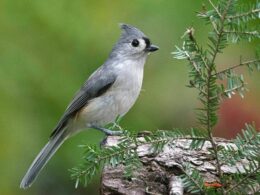Last Updated on January 9, 2024 by Greg Gillson
Did you see a brightly-colored red bird, orange bird, or yellow bird in Oregon and wonder what is was?
This page is for you!
This article shows you photos and identification of some of the most common birds in Oregon based on color.
The list of birds found in Oregon includes over 550 species. So, I can’t show you all of them. I’m going to assume that you saw a common bird of this color, but you certainly could have seen something less common, or even rare!
Shape (including the shape of the bill) and size are often more helpful in starting to identify a bird than the color. In fact, most birds in North American can be easily identified with a black-and-white photo!
Many birds are multi-colored, so that it may be hard to pick out a dominant color. Males and females may be colored quite differently. And some color patterns are similar among otherwise dissimilar species.
Nevertheless, I’m going to try to pick out some of the birds that you are most likely to see in backyards or towns. And I’ll show a few others that I get asked about a lot.
The birds with a noticeable amount of red on them in Oregon covered in this article are:
- American Robin
- Anna’s Hummingbird
- House Finch
- Purple Finch
- Red-breasted Sapsucker
- Red Crossbill
The birds with a noticeable amount of orange on them in Oregon covered in this article are:
- Barn Swallow
- Spotted Towhee
- Northern Flicker
- Red-breasted Nuthatch
- Chestnut-backed Chickadee
- Black-headed Grosbeak
- American Kestrel
- Varied Thrush
- Rufous Hummingbird
- Ruddy Duck
- Cinnamon Teal
- Cooper’s Hawk
- Bullock’s Oriole
The birds with a noticeable amount of yellow on them, including lots of yellow and black birds, in Oregon covered in this article are:
- Yellow-rumped Warbler
- Lesser Goldfinch
- American Goldfinch
- Western Tanager
- Cedar Waxwing
- Pine Siskin
- Common Yellowthroat
- Western Meadowlark
- Wilson’s Warbler
- Yellow Warbler
- Townsend’s Warbler
- Evening Grosbeak
- MacGillivray’s Warbler
- Western Kingbird
Red birds of Oregon
Birds get the red, orange, and yellow in their feathers from carotenoids in the fruit, seeds, and plants they eat (source).
These carotenoid colors combine with melanin to form an infinite range of red feathers–pink, rusty, scarlet, violet, red-orange.
The following are red birds that you are most likely to see in Oregon.
American Robin
These are familiar lawn birds with red breasts.
 |
| American Robin. Greg Gillson. |
Male American Robins are brownish-gray above with a brick red breast. Females are paler orange below and paler gray above.
They are widespread in open country with scattered deciduous trees, residential areas.
American Robins are year-round residents throughout Oregon.
Anna’s Hummingbird
These are larger hummingbirds with red heads that don’t migrate.
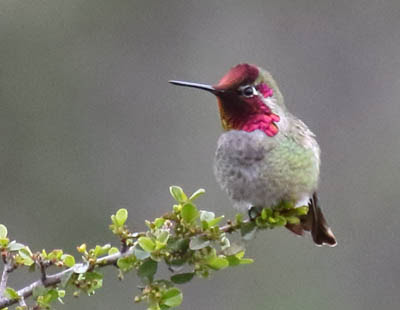 |
| Male Anna’s Hummingbird. Greg Gillson. |
These are big green hummingbirds. Adult males have the entire head red–forecrown and throat, actually. The color of the iridescent feathers is amethyst, a bright reddish purple color, tending towards pink.
Young males have just a spot of red on the center of the throat.
Females lack red, but often show a spot of iridescent green feathers on the center of the white throat. The upper breast is gray. The lower belly and flanks have a greenish tinge. Many other western hummingbird species have cinnamon color under the tail.
They are common in flower gardens and hummingbird feeders year-round.
Anna’s Hummingbirds are year-round residents in the western half of Oregon, summer residents in south-central Oregon.
House Finch
When people ask about a bird with a red head at their feeder, it is usually this bird.
 |
| Male House Finch. Greg Gillson. |
Males of this dusty brown striped finch have red limited to the head (specifically the forehead and eyebrow), breast (chest), and rump. The red coloration tends toward orangish, and may rarely be yellowish.
Females are streaked, similar to the males but without red. They lack any strong pattern on the face and head.
Note the small round head and curved upper ridge on the bill.
Some people call these red-headed sparrows. Sparrows and finches are similar, but in general, male finches are brighter than the females and tend to hang out more in trees. Sparrow genders are usually quite similar in coloration and tend to feed mostly on the ground.
These birds are common in residential areas, especially at bird feeders. In the West more widespread in arid regions near water.
House Finches are year-round residents throughout Oregon.
Purple Finch
Forest finches of the foothills, delicately frosted in pinkish-red.
 |
| Male Purple Finch. Greg Gillson. |
Told from more common House Finch by bigger square or peaked head, bigger bill, lacks sharp striping below, deeply notched tail. Red covers all plumage.
Females lack red color, shows strongly patterned dark ear patch outlined all around with a pale stripe, is heavily streaked below.
Found in foothills and damp mountains conifers and mixed woods. Visit feeders, but less frequently than House Finches.
Purple Finches are year-round residents in western Oregon, summer residents in mountains in eastern Oregon.
Red-breasted Sapsucker
If you see a “red-headed woodpecker” in the West, it is likely this common species.
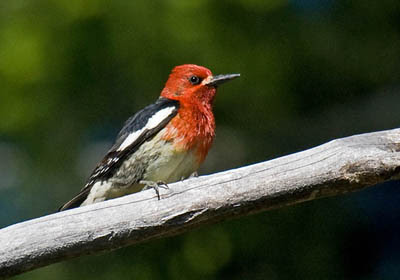 |
| Red-breasted Sapsucker. Greg Gillson. |
The red covers the entire head and upper breast. Northern populations are deeper red; those in California paler, often with white line down neck from bill. The bold white wedge in the wing is typical of all sapsuckers.
They live in mixed woods and mountain forests. Visit orchards, parks in winter.
Red-breasted Sapsuckers are year-round residents in western Oregon.
Red Crossbill
These red finches use their uniquely crossed bills to pry seeds from cones.
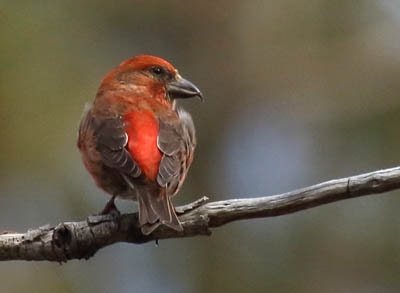 |
| Red Crossbill. Greg Gillson. |
Males are deep red with blackish wings and forked tail.
Females more yellowish-green.
Always found in conifers, frequently in the mountains. Much variation in bill size. Smaller-billed populations feed on small spruce and fir cones. Larger-billed populations feed on large hard pine cones.
Red Crossbills are year-round residents throughout most of Oregon, winter visitors only in southeastern Oregon.
Orange birds of Oregon
True orange-colored birds are not that common. Many birds that I have here are paler rusty.
The common pattern is an orange body and black or brown wings and tail. Another common pattern is for the orange to be restricted to the under parts.
The following are orange birds that you are most likely to see in Oregon.
Barn Swallow
These orange-bellied birds are a familiar sight across North America in summer.
 |
| Barn Swallow. Greg Gillson. |
These birds are purple-blue above with orange under parts and long forked tails. The color of the underparts in winter or on females are often cinnamon or buff-colored, but breeding males can be brighter orange-red.
These birds swoop low over fields and wetlands at lower elevations. They may build their mud nests in rafters on porches, garages, or other out-buildings.
Barn Swallows are summer residents throughout Oregon.
Spotted Towhee
These big sparrows with red sides superficially resemble the coloration of robins.
 |
| Spotted Towhee. Greg Gillson. |
These birds have dark hoods and upper parts with rusty rufous-red sides and white bellies. They have white spots over their wings, shoulders, and on their tail corners. The upper parts of the males are jet black, females dark brown. Some populations have paler orange sides.
These are somewhat shy birds that hide in the dense brush and spend most of their time on the ground. They visit feeders during quiet periods.
Spotted Towhees are year-round residents throughout most of Oregon.
Northern Flicker
These unusual woodpeckers with orange under wings are just as likely to be found hopping on your lawn eating ants as they are to be calling from a dead tree top.
 |
| Northern Flicker. Greg Gillson. |
Where is the orange color?
Wait for it…
 |
| Northern Flicker. Greg Gillson. |
The shafts and undersides of the wing and tail feathers are a salmon orange color. A large white rump patch also attracts attention as these birds fly away.
Northern Flickers live in open woods, residential areas. Sometimes visit feeders in winter.
Northern Flickers are year-round residents throughout Oregon.
Red-breasted Nuthatch
These active little red-breasted birds crawls all around on the trunk and big branches of conifers. They search crevices in the bark for insect food.
 |
| Red-breasted Nuthatch. Greg Gillson. |
These tiny birds have blue-gray backs and a black line through a white face. Some males can have quite bright rusty red under parts. Some females can have quite pale buff-colored under parts. Most birds show an orange-cinnamon breast color.
Found nearly exclusively in conifers. Readily come to feeders.
Red-breasted Nuthatches are year-round residents in western Oregon and mountains of northeastern Oregon, winter visitors throughout.
Chestnut-backed Chickadee
These chickadees show brownish-orange coloration on the body.
 |
| Chestnut-backed Chickadee. Greg Gillson. |
These small birds are gray with white face, black bib, and brown cap. They show a chestnut-brown back.
Birds in the north show brown-orange sides, which birds in the San Francisco area lack.
They are found in coniferous and mixed woods, often in foothills. Readily visit feeders.
Chestnut-backed Chickadees are year-round residents in western Oregon and mountains of northeastern Oregon.
Black-headed Grosbeak
If you didn’t look closely at these big-billed birds, you might mistake these orange-breasted songsters for American Robins–their coloration and song are very similar!
 |
| Male Black-headed Grosbeak. Greg Gillson. |
Males have black and white wings and tail. Huge bill. The under parts are burnt orange, fading to yellow-orange mid-belly.
Females and first year birds have a striped heads and are brown above, pale buff or butterscotch-orange below.
These birds are found in deciduous or mixed woods. Visit bird feeders.
Black-headed Grosbeaks are summer residents throughout Oregon.
American Kestrel
These are the familiar small rusty-orange falcons sitting on power lines on the edge of the highway, or hunting and hovering over the median strip.
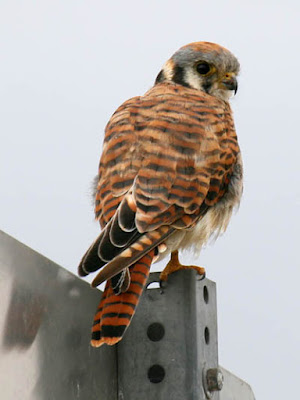 |
| Female American Kestrel. Greg Gillson. |
Females are rusty orange barred with black on their back wings and tail. The under parts are buff with black spots. The head shows two facial stripes.
Males have blue-gray backs and rufous tail is unmarked except for black tail band.
These birds are found in open country, farms, pastures with perches.
American Kestrels are year-round residents throughout Oregon.
Varied Thrush
These birds of deep damp forests look like orange-breasted robins with black chest bands.
 |
| Varied Thrush. Greg Gillson. |
These birds have slate upper parts and orange under parts. They have orange eyebrow stripe back from the eye, orange wing bars. They show a black band crossing the chest.
Females are somewhat paler than males.
These birds are found in the under story and fern-covered floor of deep wet conifer forests. Visit backyards when snow forces them down from the hills in winter.
Varied Thrushes are year-round residents in western Oregon and mountains of northeastern Oregon, winter visitors throughout (rare in southeastern Oregon).
Rufous Hummingbird
These are the common widespread hummingbirds of the Pacific Northwest and Alaska. These orange birds don’t like to share the hummingbird feeder–frequent chases are the norm.
 |
| Rufous Hummingbird. Greg Gillson. |
Males are all-over rusty orange, tending to pinker cinnamon on the under parts. Even the back and rump and base of the tail feathers are orange. Males have a bright red throat gorget when the sunlight catches it just right.
Females are green above, with a small green or red spot in the center of the white throat. Flanks and sides cinnamon. Tail base orange.
These birds are found in forest edges, yards, in all but the highest mountains.
Rufous Hummingbirds are summer residents throughout Oregon.
Ruddy Duck
These small ducks are dark rusty-orange in spring.
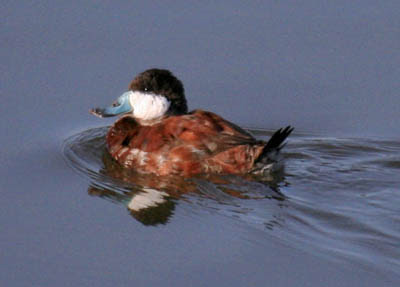 |
| Ruddy Duck. Greg Gillson. |
Males in breeding plumage (late winter and spring) are rusty, with a white face, and a blue bill. The long tail is often held sticking up. In winter they are brown, with white face, and dark bill.
Females all year are like winter males. Brown body, dark cap, dark line through eye of pale face. Dark bill.
These birds prefer weedy ponds to breed, but in winter may be found in deeper ponds in city parks.
Ruddy Ducks are year-round residents in south-central and southeastern Oregon, summer residents in northeastern Oregon, and winter visitors in western Oregon.
Cinnamon Teal
What an unusually colored brownish-orange duck!
 |
| Male Cinnamon Teal. Greg Gillson. |
Males are dark cinnamon orange. The wing patches are blue, green, and white. The eye is red.
Females are more mottled brown with matching wing patches.
These birds are found in ponds and grass-lined ditches.
Cinnamon Teals are summer residents throughout Oregon.
Cooper’s Hawk
These crow-sized hawks with reddish orange bars on the under parts may show up in fall or winter to hunt birds at your feeder. Oh no!
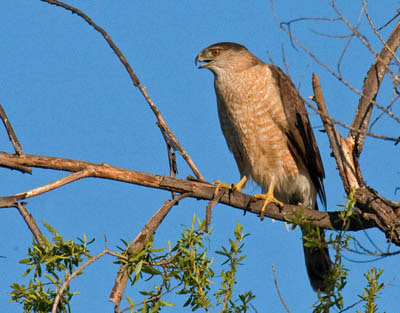 |
| Cooper’s Hawk. Greg Gillson. |
Adults with long gray and black banded tail. Dark gray above and cap on head. Under parts barred with rusty orange.
Immatures similar, brownish, streaked with brown on under parts.
Found in forests and woodlands, residential shade trees.
Cooper’s Hawks are year-round residents throughout Oregon.
Bullock’s Oriole
These bright orange and black birds are often seen in tall trees.
 |
| Male Bullock’s Oriole. Greg Gillson. |
The males of this species are very bright orange. The back and top of the heads are black. The black wings have large white wing patches. The tail is black with orange sides. The face is orange with a black line through the eye and a black throat.
Females and young are gray with yellow head and breast and tail.
These birds are more common in drier inland regions along watercourses in tall cottonwoods or shade trees. Rarely come to feeders for fruit or nectar in spring.
Bullock’s Orioles are summer residents throughout Oregon, except absent along the coast.
Yellow birds of Oregon
Yellow is a common bird color! Often it is mixed with black and white plumage in birds.
Many birds with darker upper parts have yellow breast or belly.
The following are yellow birds you are most likely to see in Oregon.
Yellow-rumped Warbler
These are abundant warblers across North America. Affectionately called “butter butts” by many birders, because of their bright yellow rumps that flash in flight.
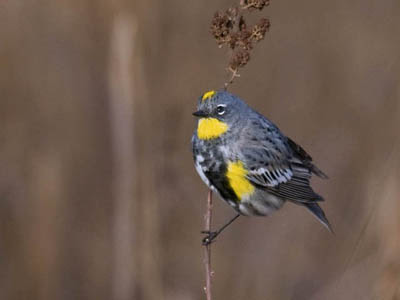 |
| Male Audubon’s Yellow-rumped Warbler. Greg Gillson. |
Western form (Audubon’s) with bright yellow throat and yellow rump. Large white wing patch.
Northern and Eastern form (Myrtle) with white throat, yellow rump, and two white wing bars.
Winter birds are dull gray brown, with bright yellow rump. Throat may be cream colored or white. Often difficult to tell the two forms apart in winter.
 |
| Winter Yellow-rumped Warbler. Greg Gillson. |
Breed in mountain or boreal conifers. Widespread in migration. Winter in low river bottoms, open weedy deciduous areas. Rarely come to feeders in winter.
Yellow-rumped Warblers are summer residents in mountains of central and northeastern Oregon, winter visitors throughout.
Lesser Goldfinch
Lesser Goldfinches maintain their bright yellow plumage all year–even in the winter when American Goldfinches are rather brown and colorless.
 |
| Male Lesser Goldfinch. Greg Gillson. |
These tiny birds are bright yellow below (including under the tail), and green or black on the back. The wings and tail are black and white. Males have a black cap, which the females lack.
These birds are found near water in arid regions of the West and Southwest. They are common in residential areas, too, and come to bird feeders.
Lesser Goldfinches are year-round residents inland in western Oregon, summer residents in south central Oregon.
American Goldfinch
These small little birds are bright yellow and black.
 |
| American Goldfinch. Greg Gillson. |
Males are bright lemon yellow with black and white wings and tail, black cap. White under tail coverts. Pink bill.
Females are duller yellow below and brownish above. Lack black cap.
Winter birds are pale brown or gray, a touch of yellow on the throat of males.
These are birds of open country, fields with saplings, clear cuts, residential areas. They avoid dense forests, mountains, deserts. They visit feeders.
American Goldfinches are year-round residents in Oregon.
Western Tanager
Numbers of these bright black and yellow birds may show up overnight in backyards in spring migration. Then they disappear the next night.
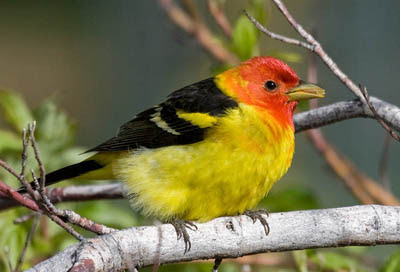 |
| Western Tanager. Greg Gillson. |
Males are brilliant golden yellow with black back, wings, and tail, and a red or orange face. Swollen yellow bill.
Females are more green or gray, with darker wings and tail. Lack red face.
They are found in a variety of wooded habitats, usually conifers or mixed conifer woods, and residential areas with large trees, including mature conifers. Usually don’t visit feeders.
Western Tanagers are summer residents in western Oregon and northeastern Oregon.
Cedar Waxwing
These crested birds with yellow band on the end of the tail are often found in flocks. They eat flying insects in summer, fruit and berries the rest of the year.
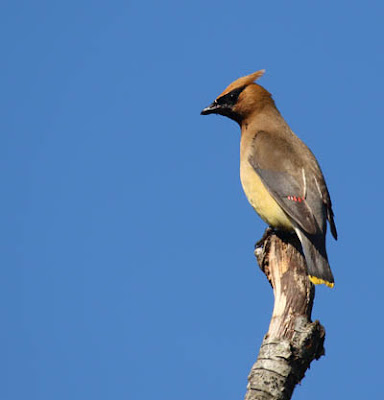 |
| Cedar Waxwing. Greg Gillson. |
These birds are fawn-brown above, with dark gray wings and tail. They have a black mask and wispy crest. The belly is yellow. The wings have waxy red drops on the end of the tertials. The end of the tail has a brilliant yellow tail band.
They are found in open habitats with berries, including juniper woodlands and towns in winter.
Cedar Waxwings are year-round residents throughout Oregon.
Pine Siskin
These small brown-streaked birds are relatives of the goldfinches. But you would never know it until they fly and sport yellow wing stripes and tail base. Usually in flocks.
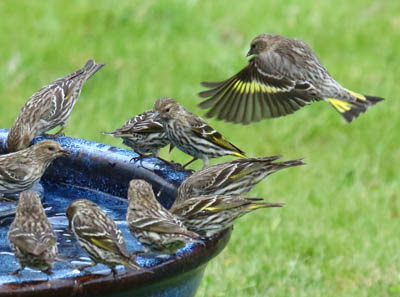 |
| Pine Siskin. Greg Gillson. |
These birds are streaked brown. In flight they have a yellow stripe down the length of the wing. The sides of the base of the tail is also yellow. Some birds are paler, some darker, others brighter yellow, others duller.
These birds are found in summer in northern conifer woods. Irregularly irrupt hundreds of miles southward. Frequent at feeders.
Pine Siskins are year-round residents in western and northeastern Oregon, winter vistors throughout.
Common Yellowthroat
These buttery yellow birds are abundant in the marsh vegetation.
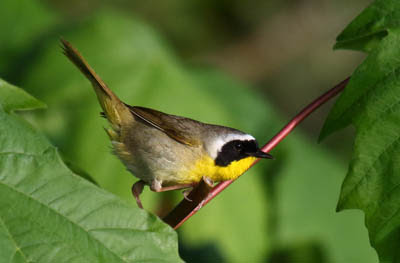 |
| Male Common Yellowthroat. Greg Gillson. |
These skulkers have bright yellow throats and yellow undertail coverts. Males have a black domino mask edged broadly in white, which females lack. Upperparts are dull olive-green.
Immature males in fall show a shadowed black mask.
Found in damp situations and heavy deciduous brambles following clear cuts.
Common Yellowthroats are summer residents throughout Oregon except in high mountains.
Western Meadowlark
These are streaky camouflaged prairie birds from above or from behind. But from the front, the breast is shocking yellow!
 |
| Western Meadowlark. Greg Gillson. |
They are streaked brown, black, and gray on the upper parts. The underparts are golden yellow with a black necklace crossing the upper breast. Much paler yellow in fall and winter, as the yellow feathers are tipped with white and streaked with brown.
These are birds of pastures and grasslands and arid regions.
Western Meadowlarks are year-round residents throughout Oregon, summer residents only in far northeastern Oregon.
Wilson’s Warbler
These bright yellow birds are very common, both on their summer territories and in migration.
 |
| Male Wilson’s Warbler. Greg Gillson. |
These birds are bright yellow in the West, more greenish above in the East. Only males have the black cap.
Both genders have a beady black eye in the middle of the yellow face.
These birds live in damp understory, tangles, willows.
Wilson’s Warblers are summer residents in western and northeastern Oregon, spring and fall migrants throughout.
Yellow Warbler
The golden yellow sun packed all into one little bird! Appears to be an all-yellow bird.
 |
| Yellow Warbler. Greg Gillson. |
Some populations are bright yellow, some tend toward greenish on upper parts, some more golden. Yellow internal tail corners in flight.
Males with red breast streaking, again, variable by population.
Females somewhat to much paler yellow, some greenish, some whitish. Lack red streaks.
These birds are found in willow thickets on the edge of wetlands and ditches, stream sides in arid regions.
Yellow Warblers are summer residents throughout Oregon.
Townsend’s Warbler
What beautiful woodland birds–yellow with striking black patterns on the head and face!
 |
| Male Townsend’s Warbler. Greg Gillson. |
These little birds have yellow face and breast. Black crown, ear patch. Black throat on male, lacking on female. Back is green. Wings gray with two wide white wing bars. Show dark gray tail with white outer tail feathers in flight.
Breeds in conifer mountain forests. Winters in lowlands, oaks and conifers, residential trees.
Townsend’s Warblers are summer residents in northern Cascade Mountains of western Oregon, and mountains of northeastern Oregon. Townsend’s Warblers are winter visitors in western Oregon, spring and fall migrants throughout.
Evening Grosbeak
These large yellow northern finches are usually found in flocks.
 |
| Evening Grosbeaks. Greg Gillson. |
Males are brilliant yellow, with black and white wings. Dusky brown head with bold yellow eyebrow. Huge thick yellow-green bill. White wing patches in flight.
Females are grayer with yellow hind collar, black and white wings. Huge yellow-green bill.
These are birds of northern conifer forests. They often descend to the lowlands in spring to eat seeds of maples, elms.
Evening Grosbeaks are year-round residents in western and northeastern Oregon, winter visitors throughout.
MacGillivray’s Warbler
These are yellow-bellied birds of brushy clear cuts.
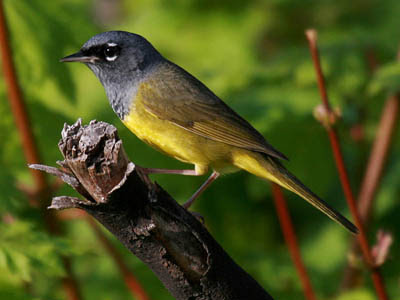 |
| MacGillivray’s Warbler. Greg Gillson. |
These ground-loving birds have gray hoods with white eye arcs. Rest of upper parts green. Breast, belly, under tail bright yellow.
Females have slightly paler gray hood, but are otherwise similar to males.
These birds love brushy clear cuts, tangles, thick cover. They stay low.
MacGillivray’s Warblers are summer residents in western and northern Oregon.
Western Kingbird
These yellow-bellied birds of the prairies often perch on power lines and fence lines.
 |
| Western Kingbird. Greg Gillson. |
These birds are pale gray on the head and breast. Brown wings. The belly is lemon yellow. Black tail has white outer tail feathers, especially obvious in flight.
These are birds of prairies, deserts, pastures, often near water.
Western Kingbirds are summer residents in the eastern two-thirds of Oregon.
Wrapping Up
Here are my top favorite red, orange and yellow birds of Oregon:
Red-breasted Sapsucker: This small woodpecker sports a bright crimson bib on its neck, contrasting with its black and white body pattern. They drum on trees to attract insects and feed on sap, and you can find them in forests and woodlands across Oregon.
Frequently Asked Questions
Are there any cardinal birds in Oregon?
No, native populations of Northern Cardinals (Cardinalis cardinalis) are not found in Oregon. Their natural range primarily encompasses eastern and central North America, extending from Maine and Nebraska south to Florida and Texas, with some populations reaching southern Arizona and New Mexico. While the occasional individual has been documented in Oregon, these are extremely rare vagrants, likely birds that have strayed far beyond their typical range.
The western counterpart to the Northern Cardinal is the Pyrrhuloxia (Cardinalis sinuatus). Found in the arid southwestern United States and northern Mexico, their range does not extend far enough north to overlap with Oregon.
What kind of bird is black-and-white with a red head in Oregon?
Several black-and-white birds with a red head could be found in Oregon, depending on the size, habitat, and other details you might have observed. Here are some possibilities:
Woodpeckers:
- Black-backed Woodpecker: This medium-sized woodpecker has a black body with white stripes on its wings and belly, a crimson cap, and white under its eyes. They thrive in coniferous forests throughout Oregon.
- Hairy Woodpecker: Similar in size and markings to the Black-backed Woodpecker, but the male Hairy Woodpecker has a red patch on the nape of its neck, while females lack it. They are widespread in forests across Oregon.
Other options:
- American Robin: While not strictly black-and-white, male American Robins have a bright red breast that contrasts with their black head and slate-gray back. They are common year-round residents in diverse habitats throughout Oregon.
- Red-breasted Sapsucker: This small woodpecker has a black body with white stripes on its wings and underparts, a crimson breast and throat, and a white spot in front of its eye. They are found in coniferous forests, especially in western Oregon.
- Pileated Woodpecker: This large woodpecker boasts a bold black and white plumage with a striking red crest. They prefer mature forests in various habitats across Oregon.
To narrow down the possibilities, consider factors like:
- Size: Was the bird small, medium, or large?
- Habitat: Where did you see the bird? Forest, backyard, open fields, etc.?
- Bill: Was the bill long and sharp like a woodpecker’s, or shorter and stubbier?
- Other markings: Did it have any other notable features like white wing bars, stripes on the face, or a white belly?
What is a black bird with a red wing Oregon?
Red-winged Blackbird: This is the most likely option, especially if you saw the bird near water or open fields. They are very common across North America, including Oregon, and their appearance matches your description:
- Males: Glossy black body with a bright red wing patch bordered by yellow.
- Females: Streaky brown body with a faint reddish wing patch.
Red-winged Blackbirds are known for their loud “oak-a-tee” song and are often seen in large flocks, especially during migration and winter.
Related Articles:
See photos and learn about the most common backyard birds in Oregon, regardless of color.
See photos and learn what to feed winter birds in Oregon. [Coming soon]
Here’s a quick tutorial of how I would teach you to identify birds: 7 Steps to Identify Birds!
Birds with red heads in North America.
Yellow-and-black birds in North America.
Little Brown Birds at your Feeder.












